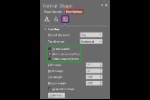Gradient fills are blended fills between two or more colors that graduate and merge from one color to another. They are sometimes also called fountain fills or blended fills in other programs. Other than applying gradients as shape fill, you can also apply Gradient fills to your Slide Background. However, make sure that the two or more colors that you use for your Gradient work well with text and other foreground elements on all your slides.
Look at the gradient backgrounds used for slides shown on the left in Figure 1, below. You'll notice that these gradients don't allow text placed above to be really readable. However, the gradient backgrounds on the right side work so much better in comparison. So always make sure that you create gradients that complement your slide content.

Figure 1: All gradients are not the same
In this tutorial, you'll learn how you can cover your slide's background with a Gradient fill in PowerPoint 2016 for Windows:
- We assume you have created a new presentation, or you have opened one of your existing presentations. We also assume that you have summoned the Format Background Task Pane, as explained in our Format Slide Background tutorial. Alternatively, just right-click within an empty area of your slide and choose the Format Background option in the resultant contextual menu (see Figure 2) to bring up the same Task Pane.

Figure 2: Format Background option - Within the Format Background Task Pane, select the Gradient fill radio button, as shown highlighted in red within Figure 3.

Figure 3: Gradient fill radio button selected - When you select the Gradient fill radio button, you can see a Live Preview of the change on the background of your active slide, which changes to a gradient fill. Hereafter, your slide background will auto-update with any changes you make in the Format Background Task Pane. The options within the Format Background Task Pane are explained below, as marked in Figure 3, above:
- Options A through E are explained in further detail in our
More Gradients tutorial. Look at points 4A through 4E on that page. The linked tutorial pertains to shape fills but techniques to create gradients remain the same for Slide Backgrounds as well. In addition, do note that the Preset gradients (Option A) includes a gallery of several ready to use default gradients that you can select for your Slide Background.
Shade from Title
- Note: When you are applying gradient fills to your Slide Backgrounds, within the Type drop-down list (Option B), you will find a new type, Shade from title, other than the regular Linear, Radial, Rectangular, and Path types (see Figure 4).

Figure 4: Shade from title gradient type - The Shade from title gradient type is unique to Slide Backgrounds, and does not show up in any of the other slide objects that can be filled with gradients. That's because only slides have titles, and depending upon the Layout you choose or customize, the title could be anywhere on the slide. It could be on the top, middle, or even the bottom of your slide. Depending upon where your slide title is located, the Shade from title gradient type applies a gradient fill to the Slide Background that begins from the slide title and ends on the edges of the slide. Figure 5 shows variations in the various layouts when we applied a gradient Slide Background with the Shade from title option selected.

Figure 5: Variations in different slide layouts when Shade from title gradient type is selected
- In addition, options F through I are related to Gradient stops. This concept is explained within our Gradient Stops in PowerPoint 2016 for Windows tutorial.
- Choose any of the options explained in the preceding step to fill your active slide with the selected gradient fill. Thereafter, you can proceed choosing any of the following options:
- Click the Apply to All button to fill all slides in the presentation with the selected gradient colors.
- Click the Reset Background button to abandon all changes you made to the slide background.
- More details about the Apply to All and Reset Background buttons can be found in our Format Slide Background in PowerPoint 2016 for Windows tutorial.
- In Figure 6, you can see the Slide Background of the entire presentation is filled with a gradient (notice the thumbnails in the left Task Pane). Also notice how the gradient begins from the slide title and ends on the edges of the slide as a result of selecting the Shade from title gradient type.

Figure 6: Presentation background applied with Shade from title gradient type - Remember to save your presentation often.









